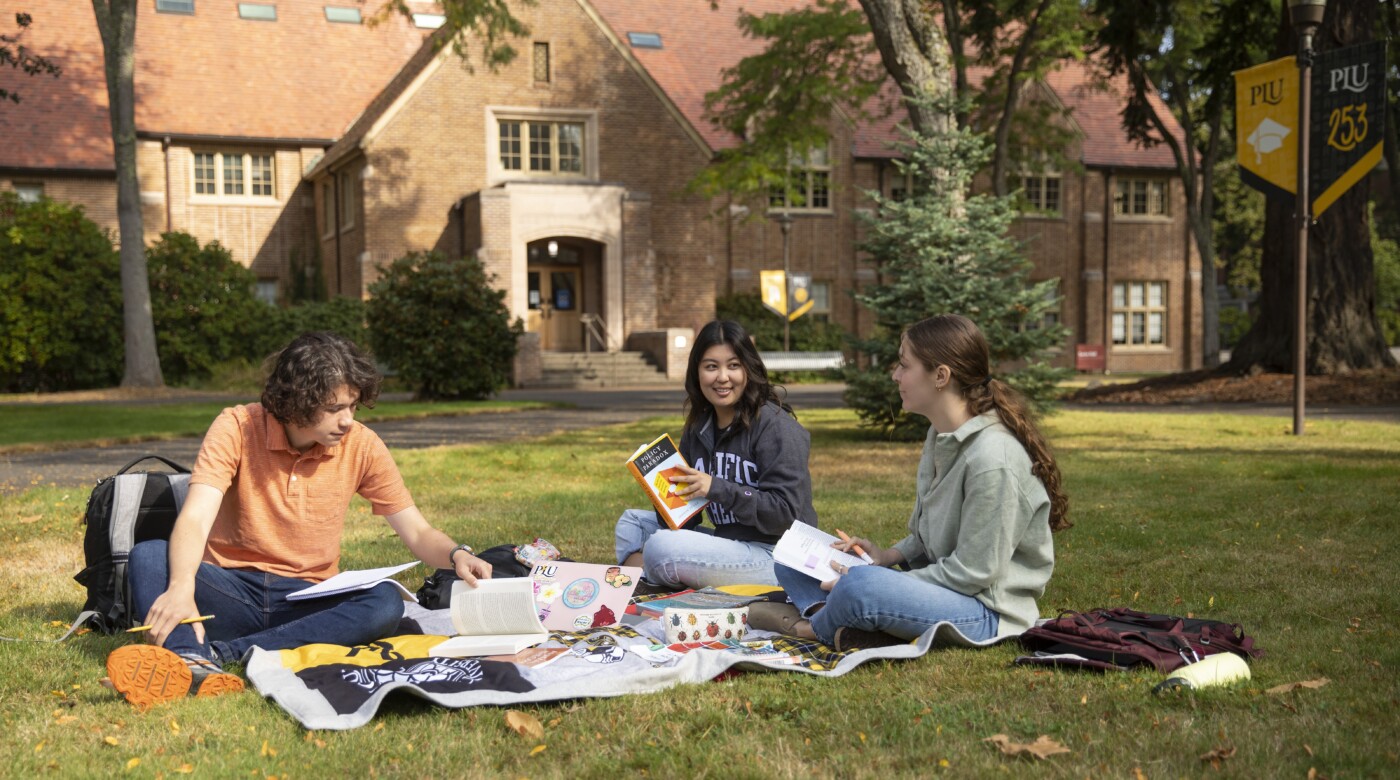You Ask, We Answer: How do I understand my financial aid offer(s)?

You’ve received your financial aid offer from PLU (and maybe some other schools?) and there’s a lot of info and terms that may be new to you and your family. What does it all mean? And how did PLU (and other universities) put this financial aid package together? What should you do next?
We’re going to tackle some of the most common questions we get from students every year (and some they don’t know they can ask!) to help you and your family understand your financial aid offers. Take a look through the list of questions below, and click those you want to know more about…or just start scrolling!
-
Can I see my PLU financial aid offer online?
-
Who can I talk to with questions about or just to review my financial aid?
-
What is “financial need” and how is it decided?
-
What if my family’s current financial situation isn’t reflected on the FAFSA?
-
What do I do if I get outside scholarships (scholarships not awarded by PLU)?
-
How do student loans work?
-
What’s the difference between subsidized and unsubsidized student loans?
-
What is the Parent PLUS loan?
-
How do we apply for the Parent PLUS loan?
-
What are the payment options for final costs?
-
What is Work Study?
Can I see my PLU financial aid offer online?
There are multiple ways we share your financial aid offer in addition to mailing it to you! PLU Student Financial Services will send you an email (from sfs@plu.edu) with instructions on how to find your offer online on Banner Self Service. You can also check out the handy video below that has the same instructions.
We’ll also post a pdf version of your offer on your student applicant portal, AND you’ll get a text a little later with a link to a personalized video that reviews your financial aid package.
Helpful Hint: Check out the ‘Do the Math’ worksheet on the back of your printed financial aid offer! It shows you how to compare final costs between the colleges you’re considering. You can also find the worksheet here.
Who can I talk to with questions about or just to review my financial aid offer?
Your PLU Admission Counselor! Our admission counselors are very well-trained to explain and answer questions about all the elements of your financial aid. They can even help you review your aid offers from other colleges! And if somehow you stump them, we can get you in touch with our Student Financial Services team.
What is “financial need” and how is it decided?
Financial need is the difference between the cost of attendance (COA), which includes tuition and fees, housing and food, books and supplies, as well as an allowance for personal and transportation costs, and the FAFSA-generated Student Aid Index (SAI). The simple equation is COA – SAI = Financial Need.
All colleges consider financial need, but that amount will differ from school to school and student to student, because costs differ between schools and students have different SAIs!
At PLU, we try to meet as much financial need as possible with your financial aid package, which can include scholarships, grants, student loans and work-study. Any outside scholarships you get can also chip away at your financial need.
What if my family’s current financial situation isn’t reflected on the FAFSA?
We understand that our students and families might be facing special circumstances that are not reflected on the FAFSA (or WASFA).
Examples of special circumstances include, but are not limited to:
- Job loss
- Reduction of income
- Loss of income due to death, divorce, or separation
- Medical expenses
- Support provided to family members not reflected on the FAFSA
- Private K-12 expenses
- College expenses for student’s sibling(s)
If you and your family are facing special circumstances and you want to be considered for additional need-based aid, you’ll need to complete PLU’s Special Circumstances Form and include supporting documentation.
Helpful Hint: Ready to submit a Special Circumstances Form? A heads up that Student Financial Services cannot accept it via email due to privacy concerns. Instead, upload your documents to our secure portal. This video shows you how.
What do I do if I get outside scholarships (scholarships not awarded by PLU)?
First, congratulations! Outside scholarships can be competitive, but can really make a difference in helping with college costs. Here’s how to let PLU’s Student Financial Services know about your scholarship(s):
- Email outsideschp@plu.edu the name and dollar amount of each scholarship that will be received during the academic year.
- Attach or include in the email any written notifications or instructions from the outside scholarship provider.
When we get outside scholarships, we may be required by federal regulations to adjust need-based aid. If an adjustment is necessary, you’ll see a change to work-study and loans first. Grants and scholarships are only adjusted if required by federal or state regulations and as a last resort.
Helpful hint: Here’s another video from Student Financial Services about outside scholarships!
How do student loans work?
On your PLU financial aid offer, you might see ‘Fed Direct Subsidized Loan’ and/or ‘Fed Direct Unsubsidized Loan’, and you’ll likely see some version of that on your other financial aid packages too.
These are federal direct loans, funded through the U.S. Department of Education and serviced by a federal loan servicer (the company you’ll make payments to when the time comes). Loans are disbursed (i.e. sent) at the beginning of each semester and the loan money (also known as ‘loan proceeds’) goes directly to your PLU student account and is applied to any university charges not covered by other aid (scholarships, grants, etc.) or by direct payments.
The idea of loans can be intimidating, but they don’t have to be scary. They are an option for you and your family to help finance your college education, but we want you to be a smart and responsible borrower. Here are some other basics about student loans that are good to know:
- Federal direct student loans would be taken out in your name, and you would be responsible for paying them back, with interest.
- Repayment on these loans begins six months after you leave the university or drop below half-time status, meaning as long as you’re a full-time student you are not required to begin loan payments (though you certainly can if you want to).
- You are required to complete a Master Promissory Note and Entrance Counseling when you agree to take out federal direct loans.
- Federal direct loans are long-term loans, meaning that repayment is usually set at 10 years (though there are other repayment plan options.)
- The interest rates on federal direct loans are fixed. That means the interest rate for a loan you take out for the 2025-26 academic year won’t ever go up.
- HOWEVER, if you take out another loan to help pay for your 2026-27 academic year, the interest rate on that loan could be different (but still fixed).
- Federal direct loan interest rates are NOT set by the U.S. Department of Education, but by federal law. You can find interest rates on this studentaid.gov webpage.
- There are fees for these loans. This is pretty normal for loans, but we don’t want you to be taken by surprise. Here’s how studentaid.gov explains it: “A loan fee comes out of the amount of money that is disbursed (paid out) to you while you’re in school. This means the money you receive will be less than the amount you actually borrow.”
- Studentaid.gov has really helpful information about federal education loans.
What’s the difference between subsidized and unsubsidized student loans?
Depending on a student’s financial need, federal direct loans can be subsidized (interest paid by the federal government) or unsubsidized.
Subsidized Loans:
This loan is awarded on the basis of financial need. If you take this loan, you won’t be charged any interest before you begin your loan repayment, because the federal government “subsidizes” the interest. In short, zero interest will accrue on your loan amount while you’re a student.
Unsubsidized Loans:
This loan is not awarded on the basis of need. If you take this loan, you will be charged interest from the time the loan is disbursed, meaning that interest will accrue (build) on the loan amount while you’re a student.
If you let the interest accumulate while you’re in school, it will be capitalized. That means the interest will be added to the principal (original) amount of your loan, and additional interest will be based on that higher amount.
Helpful Hint: One of the ways you can be a smart student borrower is to pay monthly the interest that accrues on your unsubsidized loans while you’re a student, that way it isn’t building on your original loan amount!
What is the Parent PLUS loan?
The Parent PLUS loan is a federal loan that parents can borrow on behalf of their dependent student. Unlike student loans, the loan repayment responsibility belongs to the parents. The Parent PLUS loan helps parents pay for their child’s education over an extended period of time with a fixed rate interest loan.
Unlike student loans, the Parent PLUS loan does require a credit check to be eligible. Funds are borrowed directly from the federal government through the U.S. Department of Education.
There are no annual borrowing limits set by the federal government, but eligibility is limited to the student’s cost of attendance (COA) minus any financial aid received during the loan period.
How do we apply for the Parent PLUS loan?
Parents wishing to borrow a Federal Direct Parent PLUS loan should apply with the U.S. Department of Education. Once your credit history is found to be acceptable and you complete the Master Promissory Note (MPN), the U.S. Department of Education will notify PLU of your approval. PLU will then modify your loan amount to your requested loan amount or your maximum eligibility, whichever is less, and disburse the loan proceeds onto the student’s account when they are received from the federal government.
An application will be required for each academic year parents wish to borrow.
Really important hint! Because this is a credit-based loan, a credit check is made at the time of your application. To avoid multiple credit inquiries on your credit record, do not apply before March 1 of the academic year your student will start!
What are the payment options for final costs?
There are three options to cover any remaining costs owed to PLU after financial aid:
- Financial aid (including student and parent loans) covers everything. Okay, this one isn’t really covering ‘remaining’ costs, but wanted to make sure it was listed as an option.
- Payment in full each semester.
- Monthly payments. PLU uses an outside company that specializes in monthly payment plans. To set up payments, go to Nelnet Campus Commerce Monthly Payment Plan. This option has a $42 set up fee for each semester plan, but then payments are interest free!
What is Work Study?
The video below from Student Financial Services does a great job of explaining Work Study, but if you like reading, here’s a brief explanation:
Work study is money you can earn from on- or off-campus jobs that we assume will go toward one or more of the items on your Cost of Attendance (think personal costs, for example). Heads up it’s not a guaranteed job – you still have to apply and be hired for a position. One of the cool benefits of work study, though, is that when you complete the FAFSA for next year, any amount you’ve earned in Work Study won’t count as income that could impact your SAI from the FAFSA!



Social Media